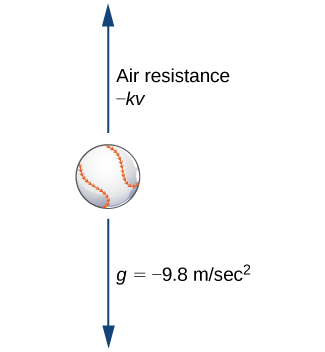| << Chapter < Page | Chapter >> Page > |
Earlier, we studied an application of a first-order differential equation that involved solving for the velocity of an object. In particular, if a ball is thrown upward with an initial velocity of ft/s, then an initial-value problem that describes the velocity of the ball after seconds is given by
This model assumes that the only force acting on the ball is gravity. Now we add to the problem by allowing for the possibility of air resistance acting on the ball.
Air resistance always acts in the direction opposite to motion. Therefore if an object is rising, air resistance acts in a downward direction. If the object is falling, air resistance acts in an upward direction ( [link] ). There is no exact relationship between the velocity of an object and the air resistance acting on it. For very small objects, air resistance is proportional to velocity; that is, the force due to air resistance is numerically equal to some constant times For larger (e.g., baseball-sized) objects, depending on the shape, air resistance can be approximately proportional to the square of the velocity. In fact, air resistance may be proportional to or or some other power of

We will work with the linear approximation for air resistance. If we assume then the expression for the force due to air resistance is given by Therefore the sum of the forces acting on the object is equal to the sum of the gravitational force and the force due to air resistance. This, in turn, is equal to the mass of the object multiplied by its acceleration at time (Newton’s second law). This gives us the differential equation
Finally, we impose an initial condition where is the initial velocity measured in meters per second. This makes The initial-value problem becomes
The differential equation in this initial-value problem is an example of a first-order linear differential equation. (Recall that a differential equation is first-order if the highest-order derivative that appears in the equation is In this section, we study first-order linear equations and examine a method for finding a general solution to these types of equations, as well as solving initial-value problems involving them.
A first-order differential equation is linear if it can be written in the form
where and are arbitrary functions of
Remember that the unknown function depends on the variable that is, is the independent variable and is the dependent variable. Some examples of first-order linear differential equations are

Notification Switch
Would you like to follow the 'Calculus volume 2' conversation and receive update notifications?